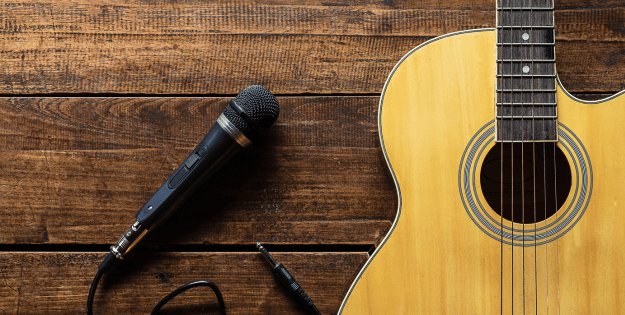For musicians, capturing the rich tones of an acoustic guitar is essential. The right microphone can make all the difference, transforming a simple performance into a captivating auditory experience. With so many options available, finding the best acoustic guitar microphones can feel overwhelming.
Whether recording in a studio or performing live, the choice of microphone influences sound quality, clarity, and overall impact. From dynamic mics to condensers, each type offers unique benefits suited to different styles and environments. This guide will explore top contenders in the market, helping guitarists select the perfect mic to enhance their sound and showcase their artistry.
Top Amazon Sellers
Key Takeaways
- Understanding Microphone Types: There are three primary types of microphones for acoustic guitars—condenser, dynamic, and ribbon—each serving different recording environments and sound preferences.
- Key Features to Consider: When selecting a microphone, pay attention to frequency response, directionality, sensitivity, and output level, as these impact sound quality and reproduction.
- Proper Mic Placement: For optimal sound capture, position the microphone 30-45 cm from the guitar, aimed at the 12th fret, and experiment with angles for the best tonal quality.
- Beginner and Budget Options: Look for beginner-friendly and budget options that maintain quality without significant financial investment, making them perfect for novice guitarists or casual use.
- Professional Recommendations: Professionals seeking advanced performance should prioritise high-quality, durable microphones that provide accurate tone reproduction for intricate acoustic environments.
Best Acoustic Guitar Microphones: An Overview
Choosing the best acoustic guitar microphones enhances sound quality and performance. Microphones vary in type, with dynamic and condenser options providing unique advantages. Dynamic microphones excel in live settings, capturing sound accurately while reducing background noise. Condenser microphones, prized for their sensitivity, deliver detailed sound reproduction, making them ideal for studio recordings.
When selecting a microphone, consider the acoustic environment and desired tonal characteristics. Positioning the microphone correctly plays a crucial role in achieving optimal sound. The right microphone pairing elevates performances, allowing musicians to showcase their artistry effectively. Understanding the various attributes of these microphones aids in making an informed decision for any acoustic guitar application.
Types of Acoustic Guitar Microphones
Different types of microphones excel in capturing the sound of acoustic guitars. Understanding these options helps musicians select the best acoustic guitar microphones based on their needs.
Condenser Microphones
Condenser microphones capture sound with exceptional detail and clarity, making them ideal for studio recordings. Their sensitivity allows for a broader frequency response, enhancing the nuanced tones of acoustic guitars. These mics typically require phantom power, suitable for both high-quality recordings and live performances.
Dynamic Microphones
Dynamic microphones are known for their durability and versatility, catering well to live performances. They handle high sound pressure levels effectively, producing a robust sound without distortion. Dynamic mics feature a narrower frequency response, focusing on the mid-range, ideal for amplifying vocals alongside acoustic guitar.
Ribbon Microphones
Ribbon microphones deliver a smooth, natural sound, capturing the warm tones of acoustic guitars. Their bidirectional polar pattern picks up sound from both front and back, producing a rich audio experience. Though they are fragile, careful use in controlled environments often yields impressive results in both studio and live settings.
Key Features to Consider
Selecting the best acoustic guitar microphones involves understanding several key features that can significantly affect sound quality.
Frequency Response
Frequency response refers to the range of sounds a microphone can capture. For acoustic guitar, a wide and flat frequency response ensures accurate reproduction of tones, capturing both high notes and low frequencies effectively.
Directionality
Directionality indicates how well a microphone captures sound from different angles. Cardioid microphones are popular for acoustic guitars, focusing on sound from the front while minimising background noise from the sides and rear.
Sensitivity and Output Level
Sensitivity measures how well a microphone converts sound into an electrical signal. A higher sensitivity allows the microphone to pick up quieter sounds, making it suitable for nuanced performances. Output level determines how strong the signal is, affecting compatibility with recording equipment.
Recommendations for Best Acoustic Guitar Microphones
Finding the right microphone enhances the sound quality of acoustic guitar recordings and performances. The following sections outline top recommendations catering to various needs and budgets.
Top Picks for Beginners
Beginner-friendly microphones combine ease of use with quality sound. These options often include user-friendly features, making them ideal for those starting with acoustic guitar recording.
Best Options for Professionals
Professional-grade microphones provide superior sound capture and durability. Musicians seeking precise tone reproduction benefit from these advanced models, designed to handle intricate performances and diverse acoustic environments.
Budget-Friendly Choices
Affordable microphones maintain sound quality without straining finances. Budget-friendly options are perfect for those who want decent performance for home studios or casual playing without significant investments.
Acoustic Guitar Recording Techniques
Effective recording techniques enhance sound quality for acoustic guitars. Choosing the right microphone and employing proper techniques greatly influences the final audio output.
Mic Placement Tips
Microphone placement significantly affects the tonal quality captured. Position the microphone 30-45 cm from the guitar, aimed at the 12th fret for a balanced sound. Experiment with angles and distances to find the desired resonance and clarity.
Essential Recording Settings
Adjust recording settings to capture the best acoustic sound. Use a moderate gain level to prevent distortion while keeping the mic sensitivity set appropriately. Set the recording software to a sample rate of at least 44.1 kHz for optimal sound fidelity.
Conclusion and Top Picks
Choosing the right microphone for an acoustic guitar can significantly enhance sound quality in both studio and live settings. By understanding the different types of microphones and their unique features musicians can make informed decisions that suit their specific needs. Proper mic placement and recording settings further optimise the audio capture process.
With a range of options available for every budget and skill level there’s no shortage of tools to help musicians achieve the perfect sound. Whether one is a beginner or a seasoned professional the right microphone can bring out the best in their acoustic guitar. Embracing experimentation will lead to discovering the ideal setup that resonates with their musical expression.
Frequently Asked Questions
What type of microphone is best for recording acoustic guitar?
Condenser microphones are often recommended for recording acoustic guitars due to their sensitivity and ability to capture detailed sound. Dynamic microphones can also work, but they might not pick up the nuances as well as condensers. Ribbon microphones offer a warm sound, making them a good choice for specific styles.
How far should I place the microphone from my acoustic guitar?
Position the microphone approximately 30-45 cm away from the guitar, aimed at the 12th fret. This distance helps capture a balanced sound, blending the guitar’s warmth and clarity.
What factors should I consider when choosing a microphone?
Consider the acoustic environment, microphone type (condenser, dynamic, ribbon), frequency response, directionality, and sensitivity/output level. These factors influence how well the microphone captures the nuances of your guitar sound.
Can I use a single microphone to record my acoustic guitar?
Yes, you can use a single microphone. However, a two-mic setup provides more depth and accuracy, allowing you to capture both the high notes from the neck and the warmth from the body of the guitar.
How do I prevent distortion when recording acoustic guitar?
To prevent distortion, adjust the gain levels on your recording device. Ensure the microphone sensitivity is suitable for the sound source, and monitor your levels to avoid clipping during recording.
What are some beginner-friendly microphones for acoustic guitar?
For beginners, microphones like the Audio-Technica AT2020 and the Rode NT1-A provide excellent quality at an affordable price. These options are user-friendly and work well in various recording situations.
What are the best microphones for professional acoustic guitar recording?
For professional recordings, consider the Neumann U87 or the AKG C414. These studio-grade microphones offer outstanding clarity and versatility, making them favourites among professional musicians and sound engineers.
How important is microphone positioning when recording?
Microphone positioning is crucial for capturing the best sound. Experimenting with angles and distances can help you find the ideal placement for optimal resonance and clarity in your recordings.












